Another round, and this time a bit more preparation.
Discovering that my opponent plays 1.e4 exclusively ( after a bad start with 1.c4 ) I aimed for the Philidor, but with the likelihood that 3...e5 would be met by 4.de and an exchange to a queenless middlegame.
Christian Bauer (The Philidor Files) considers the position after 5..Kxe8 as balanced, despite the fact that Black has lost his castling rights.
He writes : "With such a symmetrical pawn structure, only the relative activity of the pieces can disturb the balance. White can hardly change the structure to his advantage. Indeed, using his only lever, f4, causes him more problems than anything."
During the game I felt that the loss of castling barely affected me, it was a "small inconvenience" balanced by the fact that White can "hardly change the structure to his advantage", and is probably behind in development. In the game, for example, the White bishop didn't take part until move 26, and the a-rook played no effective part at all. In fact it never left it's starting square ! This non-participation of pieces is an important factor that should always be considered when assesing the material balance.
I played actively to prevent the bishop and a-rook coming into play, and indeed some of white's moves also contributed to this (13.Nge2 and 20. Ne2 ).
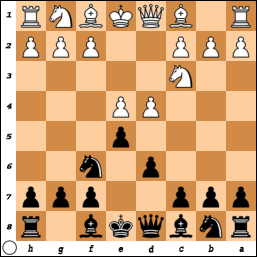 [3...e5]
[3...e5]
Subjectively, 4.Nf3 is a better choice for an opening advantage.
Many would consider 4.de leading to the Queen exchange as a 'boring' choice, probably leading to a draw. However, it still requires careful play from both sides. ( See also the additional game, Guseinov-Lorscheid, played at European Individual Championship yesterday.)
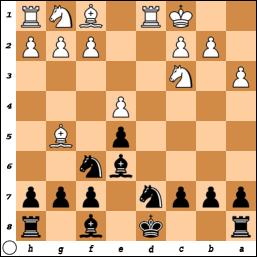 [8.a6]
[8.a6]
All was in line with preparation, but I had expected 8.f4. The text move of 8.a6 prevents Bb4, but that is all. Maybe he had bad experiences of this, as it is a key move in some variations.
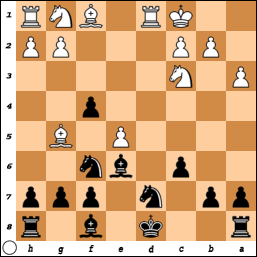 [10.e5]
[10.e5]
I played c6 to stop Nd5, and also allow Kc7, although Kc8 is given as the best move in Bauer. Other alternatives are h6 and Bd6, all played equally in my database. There is nothing wrong with 9.f4, but the follow up is Be2 or Nge2, and not e5, which hands the advantage to Black.
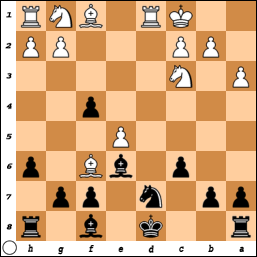 [11.Bxf6]
[11.Bxf6]
Lots of variations here, but effectively, all of them point to Bxf6 being bad for white. 11.Bxf4 is much better, giving a small edge to Black, according to shredder.
My next few moves were me keeping the tension ( and both bishops ) as long as possible.
13.Nge2 offered white's f6-pawn for black's f4. This is not a fair exchange, as the f6 pawn is hard to defend. The sequence that leads to 16...Nxf6 was straightforward and after the loss of the pawn, all white seemed to offer was to pose a series of one-trick move questions. All were tricky, but few held any sting.
15....Rhe8 is seen as better by shredder, but the exchanges through to move 17 looked good to me and gave me a definite plus of a pawn.
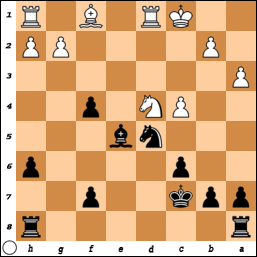 [18.c4]
[18.c4]
I didn't see 18.c4, and was probably expecting Nf3, or similar to activate the white bishop and/or rook. At first glance, a little scary, but Ne3 is an obvious move with no drawbacks.
19.Rd3 blocks the bishops scope, loses another pawn, and is really the point at which white should consider resigning. Alternatives ( ie Rd2 ) allow Black to bring his rooks into the game and press harder anyway.
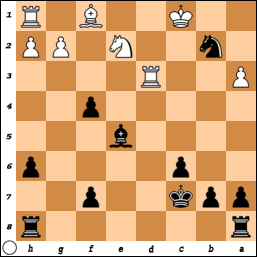 [20...Nxb2]
[20...Nxb2]
I'm still trying to work out why I didn't play Bxb2, followed by Bxa3. I felt that the knight move was better as it forced the rook away.
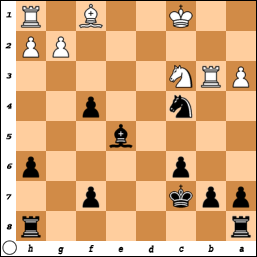 [22.Nc3]
[22.Nc3]
I didn't see this and the trick with the rook fork afterwards, but its easily defended ( either with Nc6 now or later ).
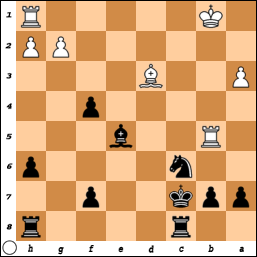 [26.Bd3]
[26.Bd3]
The bishop is out !! but really its too late. Although white tries a king-side attack, the doubled rooks and subsequent exchanges leave him completely lost.
I expected either the Bishop or the a-Rook to attack the Knight on c6, as an attempt to gain the e5 bishop, but these didn't materialise. White allowing me to double the rooks, then allow the check to put the king on the dark-squares ready for a bishop attack, assisted me.
Although shredder doesn't agree with how I went about it, the remaining moves put the white king in a mating net and although he resigns without allowing me the final coup de grace, its a good victory, as he was 200 rating points above me.
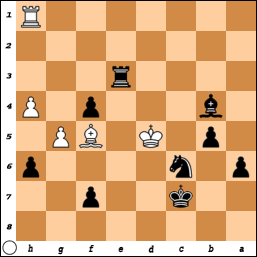 [38.Kd5...white resigns as 39.Re5 mate ]
[38.Kd5...white resigns as 39.Re5 mate ]
Overall, a justification of preparation, and in a belief that losing castling rights with the king in the centre isn't fatal.
I think a major part of the win is due to my opponent moving on blitz+ times, rather than slow. On the last move the times were 6 minutes for me and 58 for my opponent. All from a 45 minute start !
Admittedly, he gave me some challenges, but I think the difference showed when considering the vital stage from about move 9 to 16 when his seemingly quick moves didn't pay off in the end.
Here follows the full game, with annotations and some variations.
Included are 3 games starting from the position after 8.a3. Admittedly, the Nickolay game is only 11 moves, and again, since these are indexed as B07 (Pirc) its a further example of the transpositions between the Philidor, Pirc and other, similar defences.
Regardless, they show a comparison to what happened in my game, and indicate that maybe 8.a3 isn't the best move, and that 8...Bd6 is a good reply to it, as seen in Huber-Brunner.
However, with regard to the queen-exchange, see the game Guseinov-Lorscheid, played at European Individual Championship yesterday, and included below.
As Black, Gerhard Lorscheid makes a basic mistake and is already a pawn down by move 7.
This shows that even 2328-rated players miss simple tactics, or confuse their variations ! Was he aiming for the Phildor Hanham, but switched to the Antoshin variation at the last minute ? Regardless, 4...Be7 is a straightforward beginner's trap. It should have been 4...Nbd7.
06 March, 2010
Team 4545 League (T44 Round 5 )
Subscribe to:
Post Comments (Atom)

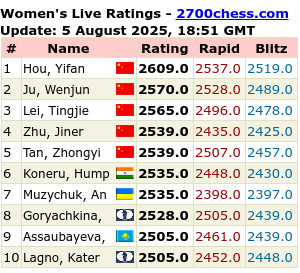
0 comments:
Post a Comment